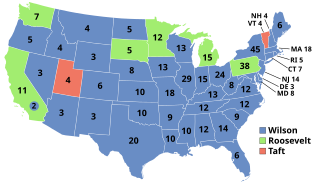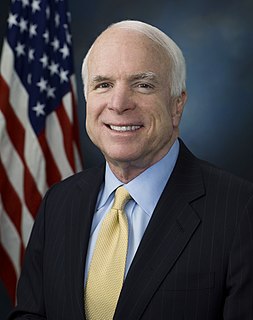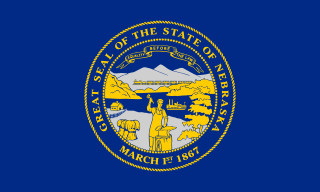Plurality voting is an electoral system in which each voter is allowed to vote for only one candidate, and the candidate who polls the most among their counterparts is elected. In a system based on single-member districts, it may be called first-past-the-post (FPTP), single-choice voting, simple plurality or relative/simple majority. In a system based on multi-member districts, it may be referred to as winner-takes-all or bloc voting. The system is often used to elect members of a legislative assembly or executive officers. It is the most common form of the system, and is used in most elections in the United States, the lower house in India, most elections in the United Kingdom, and Canada.
A two-party system is a party system where two major political parties dominate the government. One of the two parties typically holds a majority in the legislature and is usually referred to as the majority or governing party while the other is the minority or opposition party. Around the world, the term has different senses. For example, in the United States, Jamaica, and Malta, the sense of two-party system describes an arrangement in which all or nearly all elected officials belong to one of the only two major parties, and third parties rarely win any seats in the legislature. In such arrangements, two-party systems are thought to result from various factors like winner-takes-all election rules. In such systems, while chances for third-party candidates winning election to major national office are remote, it is possible for groups within the larger parties, or in opposition to one or both of them, to exert influence on the two major parties. In contrast, in the United Kingdom and Australia and in other parliamentary systems and elsewhere, the term two-party system is sometimes used to indicate an arrangement in which two major parties dominate elections but in which there are viable third parties which do win seats in the legislature, and in which the two major parties exert proportionately greater influence than their percentage of votes would suggest.

The United States presidential election of 1912 was the 32nd quadrennial presidential election, held on Tuesday, November 5, 1912. Democratic Governor Woodrow Wilson of New Jersey unseated incumbent Republican President William Howard Taft and defeated former President Theodore Roosevelt, who ran as the Progressive Party nominee. Roosevelt remains the only third party presidential candidate in U.S. history to finish better than third in the popular or electoral vote.

The United States presidential election of 1936 was the thirty-eighth quadrennial presidential election, held on Tuesday, November 3, 1936. In the midst of the Great Depression, incumbent Democratic President Franklin D. Roosevelt defeated Republican Governor Alf Landon of Kansas. Roosevelt won the highest share of the popular and electoral vote since the largely uncontested 1820 election. The sweeping victory consolidated the New Deal Coalition in control of the Fifth Party System.

The United States Electoral College is a body of electors established by the United States Constitution, constituted every four years for the sole purpose of electing the president and vice president of the United States. The Electoral College consists of 538 electors, and an absolute majority of 270 electoral votes is required to win an election. Pursuant to Article II, Section 1, Clause 2, the legislature of each state determines the manner by which its electors are chosen. Each state's number of electors is equal to the combined total of the state's membership in the Senate and House of Representatives; currently there are 100 senators and 435 representatives. Additionally, the Twenty-third Amendment provides that the District of Columbia (D.C.) is entitled to a number of electors no greater than that of the least populous state.

A first-past-the-post electoral system is one in which voters indicate on a ballot the candidate of their choice, and the candidate who receives the most votes wins. This is sometimes described as winner takes all. First-past-the-post voting is a plurality voting method. FPTP is a common, but not universal, feature of electoral systems with single-member electoral divisions, and is practiced in close to one third of countries. Notable examples include Canada, India, the United Kingdom, and the United States, as well as most of their current or former colonies and protectorates.

In American politics, the term swing state refers to any state that could reasonably be won by either the Democratic or Republican presidential candidate. These states are usually targeted by both major-party campaigns, especially in competitive elections. Meanwhile, the states that regularly lean to a single party are known as safe states, as it is generally assumed that one candidate has a base of support from which they can draw a sufficient share of the electorate.

Elections in the United States are held for government officials at the federal, state, and local levels. At the federal level, the nation's head of state, the President, is elected indirectly by the people of each state, through an Electoral College. Today, these electors almost always vote with the popular vote of their state. All members of the federal legislature, the Congress, are directly elected by the people of each state. There are many elected offices at state level, each state having at least an elective Governor and legislature. There are also elected offices at the local level, in counties, cities, towns, townships, boroughs, and villages. According to a study by political scientist Jennifer Lawless, there were 519,682 elected officials in the United States as of 2012.
FairVote is a 501(c)(3) organization that advocates electoral reform in the United States.

Nebraska's 2nd congressional district encompasses the core of the Omaha metropolitan area. It includes all of Douglas County, which includes Omaha, and the suburban areas of western Sarpy County. In the United States House of Representatives, it is currently represented by Don Bacon, a Republican.

Maine's 2nd congressional district is a congressional district in the U.S. state of Maine. Covering 27,326 square miles (70,770 km2), it comprises nearly 80% of the state's total land area. It is the largest district east of the Mississippi River and the 24th-largest overall. It is the second-most rural district in the United States, with 72.11% of its population in rural areas, behind only Kentucky's 5th congressional district.

The National Popular Vote Interstate Compact (NPVIC) is an agreement among a group of U.S. states and the District of Columbia to award all their electoral votes to whichever presidential candidate wins the overall popular vote in the 50 states and the District of Columbia. The compact is designed to ensure that the candidate who receives the most votes nationwide is elected president, and it would come into effect only when it would guarantee that outcome. As of March 2019, it has been adopted by thirteen states and the District of Columbia. Together, they have 184 electoral votes, which is 34.2% of the Electoral College and 68.1% of the 270 votes needed to give the compact legal force.
The Presidential Election Reform Act was a proposed initiative in the state of California to alter the way the state's electoral votes for president are distributed among presidential candidates.
Electoral reform in Maine refers to efforts to changing voting and election laws in the Pine Tree State. In 2004, several Maine legislators proposed a bill to lower the voting age to 17. The proposal failed, but a compromise to allow 17-year-olds to vote in primary election if 18 by general election passed. In 2007, legislation was introduced to join the National Popular Vote Interstate Compact, but it failed. Currently, Maine is the only state besides Nebraska to allocate two of its electors to the winner of the statewide popular vote and the rest according to the winner of the popular vote in each Congressional district.

The 2008 United States presidential election in Nebraska took place on November 4, 2008, as part of the 2008 United States presidential election. Voters chose 5 electors to the Electoral College, who voted for president and vice president. However, this state is one of the two states of the U.S. that, instead of giving all of its electors to the winner based on its statewide results, just 2 of them vote based on the statewide results, and the others vote based on their individual congressional district results.

The election of president and vice president of the United States is an indirect election in which citizens of the United States who are registered to vote in one of the 50 U.S. states or in Washington, D.C. cast ballots not directly for those offices, but instead for members of the U.S. Electoral College, known as electors. These electors then in turn cast direct votes, known as electoral votes, for president, and for vice president. The candidate who receives an absolute majority of electoral votes is then elected to that office. If no candidate receives an absolute majority of the votes for President, the House of Representatives chooses the winner; if no one receives an absolute majority of the votes for Vice President, then the Senate chooses the winner.

The 2012 United States presidential election in Nebraska took place on November 6, 2012, as part of the 2012 General Election in which all 50 states plus The District of Columbia participated. Nebraska voters chose five electors to represent them in the Electoral College via a popular vote pitting incumbent Democratic President Barack Obama and his running mate, Vice President Joe Biden, against Republican challenger and former Massachusetts Governor Mitt Romney and his running mate, Congressman Paul Ryan.

There have been five United States presidential elections in which the winner lost the popular vote including the 1824 election, which was the first U.S. presidential election where the popular vote was recorded. Losing the popular vote means securing less of the national popular vote than the person who received either a majority or a plurality of the vote.

The 2016 United States presidential election in Nebraska was held on November 8, 2016, as part of the 2016 General Election in which all 50 states plus The District of Columbia participated. Nebraska voters chose electors to represent them in the Electoral College via a popular vote pitting the Republican Party's nominee, businessman Donald Trump, and running mate Indiana Governor Mike Pence against Democratic Party nominee, former Secretary of State Hillary Clinton and her running mate, Virginia Senator Tim Kaine.
In the United States, a contingent election is the procedure used in presidential elections in the case where no candidate wins an absolute majority of votes in the Electoral College, the constitutional mechanism for electing the President and the Vice President of the United States. A contingent election for the president is decided by a vote of the United States House of Representatives, and the contingent election for the vice president is decided by a vote of the United States Senate. The contingent election procedure, along with the other parts of the presidential election process, was first established in Article Two, Section 1, Clause 3 of the United States Constitution, and then modified by the 12th Amendment in 1804.















